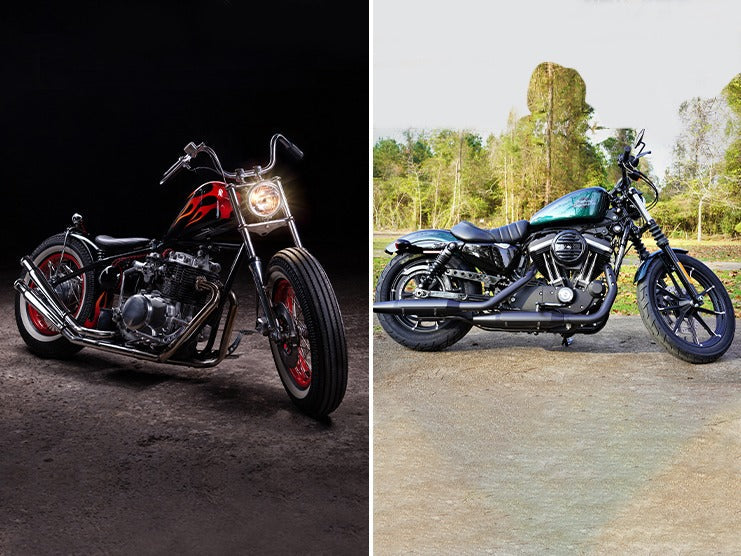The primary function of motorcycle carburetors and fuel injectors is to deliver fuel to the engine. The carburetor mixes air and fuel inside it before supplying the mixture to the engine. Meanwhile, fuel injectors deliver the fuel by directly spraying it into the engine.
This article will discuss the differences, advantages, and disadvantages between carburetors and fuel injectors.
Table of Content
| Parameter | Carburetor | Fuel Injector |
|---|---|---|
| Cold Start | Difficult to Start | Easy to Start |
| Fuel Efficiency | Low | High |
| Replacement | Easy | Difficult |
| Durability | Same | Same |
| Cost | Cheap | Expensive |
| Engine Performance | Low | High |
| Emissions | High | Low |
1. Carburetor
The carburetor is the simplest and oldest fuel system used by motorcycles. Carburetors deliver fuel to the combustion chamber by transferring gasoline through the intake vacuum. A valve attached to the throttle controls the air intake. This causes the engine to generate more power when you pull the throttle. For most carbureted engines, this procedure is mechanical and does not rely on electrical components. Because of their mechanical design, carburetors are famous for being easy to maintain, repair, and modify. However, carburetors might suffer from a delayed throttle response if there is an incorrect fuel ratio.
Carburetors are rarely used in modern times but are still found on many motorcycles. Carburetors are rarely found on beginner-level motorcycles due to releasing a lot of pollution. A carburetor can be tuned with repair tools and can be reached without making contact with the engine due to not being connected.
2. Fuel Injector
A fuel injector includes a complex set of sensors and electronics. A fuel pump controls the flow of fuel to the combustion chamber. This gasoline pump is housed within the fuel tank. An electronic control unit (ECU) controls the delivery of fuel to the combustion chamber. This electronic unit is continually monitoring and makes calculations to deliver the most optimal air-fuel ratio.
Although fuel injectors have been around since the 1930s, it was not installed on motorcycles until the 1980s. Electronic fuel injection systems also became available around this time. Unlike carburetors, which have mechanical components, EFI systems use an engine control unit to determine the optimal air-fuel ratio.
A fuel pump transports and maintains the flow of fuel in a fuel-injected system. Afterward, the fuel is atomized at specific temperatures to ensure the fuel burns cleanly and lowers fuel emissions.
Fuel-injected engines have mostly replaced carburetors in modern automobiles due to their better efficiency. Its other benefits include faster throttle response, cheaper maintenance costs, and improved power and fuel economy. Fuel-injected systems are also durable and require little maintenance.
Fuel injectors and carburetors perform the same function despite having differences. This is to guarantee a balanced mixture of fuel and air during combustion. Fuel injection is the more modern technique, while carburetors cannot perform as effectively or consistently. However, carburetors are less expensive and easier to fix than fuel injectors.
3. Carburetor Vs Fuel Injector
3.1 Cold Start
Carbureted motorcycles are more difficult to start in cold weather. Even with the choke engaged, the motorbike will occasionally fail to start.
This issue is more common in carbureted engines than in fuel-injected motorcycles. It is easier to start a fuel-injected motorcycle in low temperatures.
3.2 Fuel Efficiency
Carburetors have a set air-fuel ratio with little adjustment due to only mixing air and fuel in fixed amounts.
But for fuel injectors, the ECU modifies the ratio on a regular basis by altering the amount of fuel entering the engine based on input from the sensors.
As a result, fuel injectors offer better fuel economy than carburetors.
3.3 Replacement
Carburetors have no electronic components, making them easier to remove from your motorcycle if it becomes damaged and needs to be replaced.
Meanwhile, a fuel injector has several electronic components and is controlled by the ECU. Unfortunately, the additional electrical parts make it difficult to remove the fuel injector. You would have to take your motorcycle to a service shop to repair or replace it. Replacing the fuel injector can take more time, work, and money.
3.4 Durability
Fuel injectors and carburetors have similar durability and longevity. If you provide maintenance for your motorcycle regularly, you can extend the lifespans of both systems.
Fuel injectors and carburetors can fail if the motorcycle is not properly maintained. However the same goes for the carburetor as well. In fact, if you don’t maintain your motorcycle, both parts either the carburetor or fuel injector, are vulnerable to damage.
3.5 Cost
Carburetor components are less expensive than fuel injector parts. The difference in cost is due to the fuel injectors being more technologically advanced. The carburetor is best if you’re working with a low budget.
3.6 Engine Performance
Fuel injectors have a higher power output than carburetors. This higher power output results in higher speed.
3.7 Emission
Emissions like sulfur oxides, carbon monoxide, nitrogen oxide, hydrocarbons, and other greenhouse gasses pollute the environment.
Motorcycles that emit large amounts of carbon emissions are gradually becoming restricted by the government. It is best to own modern motorbikes that produce low emissions.
Fuel-injected bikes are much superior to carbureted motorcycles in this category. This is due to the fact that fuel injection bikes constantly adjust the air-fuel mixture to optimal levels based on riding conditions and engine parameters. This causes fuel-injected motorcycles to waste less fuel, resulting in lower emissions compared to carbureted motorbikes.
4. Advantages and Disadvantages of Carbureted Motorcycles
4.1 Advantages of Carbureted Motorcycles
- A simple, low-cost fuel system compatible with two-stroke and four-stroke motorcycles with low-capacity engines.
- Can adjust to better suit your needs and the road conditions.
- Due to its simple and mechanical design, maintenance checks and repairs are easier.
- It is readily customizable to meet the demands of the user and the surroundings.
- The feeding system prevents over-revving, making them best suited for motorcycles capable of off-roading.
- It is an ideal fueling system for cheaper, low-capacity motorbike engines.
4.2 Disadvantages of Carburetor Motorcycles
- Fluctuating fuel quantity since flow changes based on suction speed and quantity of air in the combustion chamber.
- Have poor fuel efficiency.
- Difficult starting in the cold can interfere with the fuel delivery system.
- Frequent lean or rich fuel and air mixtures.
- More emissions due to poor combustion.
- May suffer heavy vibrations and a fouled spark plug.
5. Advantages and Disadvantages of Fuel-Injected Motorcycles
5.1 Advantages of Fuel-Injected Motorcycles
- Precise amount of fuel injected and balanced air and fuel mixture ensures optimal fuel economy and power output.
- Combustion is more efficient, resulting in higher power output, optimized fuel efficiency, and reduced emissions.
- Automatically adjusts the air-fuel mixture based on riding conditions. Does not require constant adjustments.
- Decreased engine vibrations and no fouled spark plugs.
- Has no problem starting in the cold and no manual choking is required.
5.2 Disadvantages of Fuel-Injected Motorcycles
- Has a complex electrical system connected to an engine control unit and several electronic sensors.
- Repair services are limited and cannot be provided at standard workshops.
- Due to the limited maintenance and repair options, you will have to replace the entire system if it becomes damaged.
- Must be fueled by a specific quality of gasoline. Contaminated gasoline might cause the engine to stall.
- Not ideal for affordable bikes with low-capacity engines.
- Power delivery is linear most of the time. As a result, some motorcycles, such as dirt bikes, are prohibitively expensive due to the necessity for multi-mapping features in ECU.
6. Last Words
Motorcycles are either powered by the carburetor or fuel injector systems. Carburetors are the oldest and simplest fuel system, while fuel injectors are the latest technology. Both systems have their pros and cons. Carburetors are economical, easy to repair, and require minimum maintenance, but they have poor fuel efficiency, excessive emissions, and cold start problems. On the other hand, fuel injectors provide improved performance, fuel efficiency, low emissions, and high power output. Most modern motorcycles come with fuel injectors because of their efficiency and reliability. If you want to enhance your motorbike’s looks, you can use Viking Bags HANDLEBARS, FAIRINGS, SEATS, SADDLEBAGS, SISSY BARS, and CRASH BARS.












Leave a comment
All comments are moderated before being published.
This site is protected by hCaptcha and the hCaptcha Privacy Policy and Terms of Service apply.